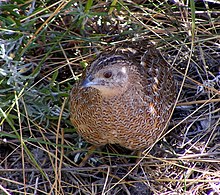Brown quail
| Brown quail | |
|---|---|
 |
|
| Scientific classification | |
| Kingdom: | Animalia |
| Phylum: | Chordata |
| Class: | Aves |
| Order: | Galliformes |
| Family: | Phasianidae |
| Subfamily: | Perdicinae |
| Genus: | Coturnix |
| Species: | C. ypsilophora |
| Binomial name | |
|
Coturnix ypsilophora Bosc, 1792 |
|
The brown quail (Coturnix ypsilophora), also known as the swamp quail, silver quail and Tasmanian quail, is an Australasian true quail of the family Phasianidae. It is a small, ground-dwelling bird and is native to mainland Australia, Tasmania and Papua New Guinea and has been introduced to New Zealand and Fiji. Widespread and common throughout its large range, the brown quail is evaluated as being of "least concern" by the International Union for Conservation of Nature on the IUCN Red List of Threatened Species.
The brown quail is a plump, stocky bird growing to a length of 17 to 22 centimetres (6.7 to 8.7 in) and weight of 75 to 140 grams (2.6 to 4.9 oz). The colour is quite variable over the bird's wide range. The male is reddish-brown speckled with black on the head and upper neck and mainly reddish-brown on back and wings. The underparts range from buff or rufous to brown, but always with fine black chevron-shaped barring. The tail is short, dark brown with yellowish barring. The female is similar but rather paler. There are small black spots on the shoulder of the female and the upperparts are barred with dark chevron-shaped markings.
The voice consists of a variety of shrill calls with which the birds communicate as they move through dense vegetation.
The brown quail is distributed in agricultural areas, wet grasslands, shrublands, Spinifex savannah, and freshwater wetlands across much of New Guinea and the Lesser Sunda Islands as well as in northern, eastern, south-eastern and south-western Australia and Tasmania, though absent from arid regions. This species has been introduced to Fiji and New Zealand. In Australia it is mostly a lowland species but in New Zealand it is found at altitudes up to 1,000 metres (3,300 ft) and in New Guinea up to 3,700 metres (12,000 ft). It was introduced to New Zealand in the 1860s and 1870s and is now present in North Island and certain offshore islands. This introduction, and other quail introductions that failed to establish, may have played a part in the demise of the New Zealand quail, an endemic species that became extinct shortly afterwards, possibly because of a lack of resistance to some new disease.
...
Wikipedia

